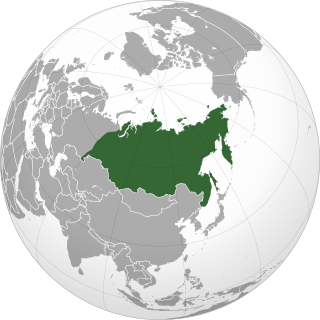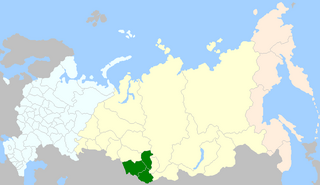
Siberia is an extensive geographical region comprising all of North Asia, from the Ural Mountains in the west to the Pacific Ocean in the east. It has formed part of the sovereign territory of Russia and its various predecessor states since the centuries-long conquest of Siberia, which began with the fall of the Khanate of Sibir in the late 16th century and concluded with the annexation of Chukotka in 1778. Siberia is vast and sparsely populated, covering an area of over 13.1 million square kilometres (5,100,000 sq mi), but home to only one-fifth of Russia's population. Novosibirsk and Omsk are the largest cities in the area.

Kets are a Yeniseian-speaking people in Siberia. During the Russian Empire, they were known as Ostyaks, without differentiating them from several other Siberian people. Later, they became known as Yenisei Ostyaks because they lived in the middle and lower basin of the Yenisei River in the Krasnoyarsk Krai district of Russia. The modern Kets lived along the eastern middle stretch of the river before being assimilated politically into Russia between the 17th and 19th centuries. According to the 2010 census, there were 1,220 Kets in Russia. According to the 2021 census, this number had declined to 1,088.

The Evens /əˈvɛn/ are a people in Siberia and the Russian Far East. They live in regions of the Magadan Oblast and Kamchatka Krai and northern parts of Sakha east of the Lena River, although they are a nomadic people. According to the 2002 census, there were 19,071 Evens in Russia. According to the 2010 census, there were 22,383 Evens in Russia. They speak their own language called Even, one of the Tungusic languages; it is heavily influenced by their lifestyle and reindeer herding. It is also closely related to the language of their neighbors, the Evenks. The Evens are close to the Evenks by their origins and culture, having migrated with them from central China over 10,000 years ago. Officially, they have been considered to be of Orthodox faith since the 19th century, though the Evens have retained some pre-Christian practices, such as shamanism. Traditional Even life is centered upon nomadic pastoralism of domesticated reindeer, supplemented with hunting, fishing and animal-trapping. Outside of Russia, there are 104 Evens in Ukraine, 19 of whom spoke Even.
The Kamchadals inhabit Kamchatka, Russia. The name "Kamchadal" was applied to the descendants of the local Siberians and aboriginal peoples who assimilated with the Russians. The descendants of the mixed-blood Russian settlers in 18th-19th century are called Kamchadals these days. The Kamchadals speak Russian with a touch of local dialects of the aboriginal languages of Kamchatka. The Kamchadals engage in fur trading, fishing, market gardening and dairy farming, and are of the Russian Orthodox faith. The Kamchadal language was a Kamchatka creole with Russian and indigenous elements.
The Chelkans are a small group of Turkic Indigenous people of Siberia. They speak the Northern Altai Chelkan language. Those residing in Altai Republic are sometimes grouped together with the Altai ethnic group and those in Kemerovo Oblast are grouped with the Shors; however, they are recognized as a separate ethnic group within the list of Indigenous small-numbered peoples of the North, Siberia and the Far East by ethnographers and the Resolution of the Government of the Russian Federation No. 255 dated March 24, 2000, and Russian Census (2002). But, during the 2010 census, they were again "united" with the Altaians. According to the 2010 census, there were 1,181 Chelkans in Russia.

Teleuts are a Turkic Indigenous people of Siberia living in Kemerovo Oblast, Russia. According to the 2010 census, there were 2,643 Teleuts in Russia. They speak the Southern Altai Teleut language/dialect.

Udege are a native people of the Primorsky Krai and Khabarovsk Krai regions in Russia. They live along the tributaries of the Ussuri, Amur, Khungari, and Anyuy Rivers. The Udege speak the Udege language, which belongs to the Tungusic language family. Their religious beliefs include animism, animal worship, and shamanism. The Udege are mainly engaged in hunting, fishing, and ginseng harvesting. According to the 2002 census, there were 1,657 Udege in Russia, a slight increase from 1,500 in 1970. This was down to 1,496 Udege in Russia in the 2010 census. They are one of the closest ethnic groups to the Manchu and Nanai, and are possibly of Xi Yeren Jurchen origin.

The Kumandins (natively, Kumandy, Kuvandy(g)) are a Turkic Indigenous people of Siberia. They reside mainly in the Altai Krai and Altai Republic of the Russian Federation. They speak the Northern Altai Kumandin language.

Telengits or Telengut are a Turkic ethnic group primarily found in the Altai Republic, Russia. Telengits mainly live in a territory of Kosh-Agach District of the Altai Republic. They are part of a larger cultural group of Southern Altaians which include Altai-Kizhi and Tolos.
The Tubalars are an ethnic subgroup of the Altaians native to the Altai Republic in Russia.

The Soyot are an ethnic group of Turkic origin who live mainly in the Oka region in the Okinsky District in Buryatia, Russia. They share much of their history with the Tofalar, Tozhu Tuvans, Dukha, and Buryat; the Soyot have taken on a great deal of Buryat cultural influence and were grouped together with them under Soviet policy. Due to intermarriage between Soyots and Buryats, the Soyot population is heavily mixed with the Buryat. In 2000, they were reinstated as a distinct ethnic group.

The Altai people, also the Altaians, are a Turkic ethnic group of indigenous peoples of Siberia mainly living in the Altai Republic, Russia. Several thousand of the Altaians also live in Mongolia and China but are not officially recognized as a distinct group and listed under the name "Oirats" as a part of the Mongols, as well as in Kazakhstan where they number around 200. For alternative ethnonyms see also Tele, Black Tatar, and Oirats. During the Northern Yuan dynasty, they were ruled in the administrative area known as Telengid Province.
Russia, as the largest country in the world, has great ethnic diversity, is a multinational state, and is home to over 190 ethnic groups nationwide. According to the population census at the end of 2021, more than 147.1 million people lived in Russia, which is 4.3 million more than in the 2010 census, or 3.03%. At the same time, only 130.587 million census participants indicated their nationality. The top ten largest nations besides Russians included in descending order: Tatars, Chechens, Bashkirs, Chuvash, Avars, Armenians, Ukrainians, Dargins and Kazakhs. Population censuses in Russia allow citizens to report their nationality according not only to their ancestry, but also to self-identification. The 83 federal subjects which together constitute the Russian Federation include:

Siberia is a vast region spanning the northern part of the Asian continent, and forming the Asiatic portion of Russia. As a result of the Russian conquest of Siberia and of the subsequent population movements during the Soviet era (1917-1991), the modern-day demographics of Siberia is dominated by ethnic Russians (Siberiaks) and other Slavs. However, there remains a slowly increasing number of Indigenous groups, accounting for about 5% of the total Siberian population, some of which are closely genetically related to Indigenous peoples of the Americas.
The Indigenous small-numbered peoples of the North, Siberia and the Far East is a Russian census classification of Indigenous peoples, assigned to groups with fewer than 50,000 members, living in the Russian Far North, Siberia or Russian Far East. They are frequently referred as Indigenous small-numbered peoples of the North or Indigenous peoples of the North.
Ostyak is a name formerly used to refer to several indigenous peoples in Siberia.









